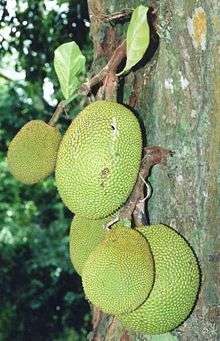Gamboge
| Gamboge | |
|---|---|
| Hex triplet | #E49B0F |
| sRGBB (r, g, b) | (228, 155, 15) |
| CMYKH (c, m, y, k) | (0, 35, 94, 6) |
| HSV (h, s, v) | (38°, 94%, 94%) |
| Source | Maerz and Paul[1] |
|
B: Normalized to [0–255] (byte) H: Normalized to [0–100] (hundred) | |
Gamboge (/ɡæmˈboʊʒ/ gam-BOHZH, /ɡæmˈboʊdʒ/ gam-BOHJ, or /ɡæmˈbuːʒ/ gam-BOOZH)[2] is a partially transparent deep saffron to mustard yellow pigment.[Note 1] It is used to dye Buddhist monks' robes[3][4] because the color is a deep tone of saffron, the traditional color used for the robes of Theravada Buddhist monks.
Production
Gamboge is most often extracted by tapping resin (sometimes incorrectly referred to as sap) from various species of evergreen trees of the family Clusiaceae (also known as Guttiferae). The tree most commonly used is the gamboge tree (genus Garcinia), including G. hanburyi (Cambodia and Thailand), G. morella (India and Sri Lanka), and G. elliptica and G. heterandra (Myanmar).[5] The orange fruit of Garcinia gummi-gutta (formerly called G. cambogia) is also known as gamboge[6] or gambooge.
The trees must be at least ten years old before they are tapped.[7] The resin is extracted by making spiral incisions in the bark, and by breaking off leaves and shoots and letting the milky yellow resinous gum drip out. The resulting latex is collected in hollow bamboo canes.[5] After the resin is congealed, the bamboo is broken away and large rods of raw gamboge remain.
Etymology
The word gamboge comes from gambogium, the Latin word for the pigment, which derives from Gambogia, the Latin word for Cambodia.[8] Its first recorded use as a color name in English was in 1634.[9]
New gamboge
"New gamboge" is synthetic yellow pigment. The pigment has a color similar to that of natural gamboge.[10]
See also
- Gambooge
- Hooker's green, made by mixing gamboge with Prussian blue
Notes
- ↑ Other forms and spellings are: cambodia, cambogium, camboge, cambugium, gambaugium, gambogia, gambozia, gamboidea, gambogium, gumbouge, gambouge, gamboge, gambooge, gambugia. (Oxford English Dictionary)
References
- ↑ The color displayed in the color box above matches the color called gamboge in the 1930 book by Maerz and Paul A Dictionary of Color New York:1930 McGraw-Hill; the color gamboge is displayed on page 43, Plate 10, Color Sample K6.
- ↑ Oxford English Dictionary, 2nd Ed. (1989)
- ↑ Hanelt, Peter (11 May 2001). Mansfeld's Encyclopedia of Agricultural and Horticultural Crops: (Except Ornamentals). Springer. Retrieved 8 August 2011.
- ↑ Lewington, Anna (1990). "Recreation-Plants that entertain us". Plants for people. London: Natural History Museum Publications. p. 206. ISBN 0-565-01094-8.
- 1 2 Nicholas Eastaugh; Valentine Walsh; Tracey Chaplin; Ruth Siddall (2004). The Pigment Compendium: A Dictionary of Historical Pigments. Butterworth-Heinemann. ISBN 0-7506-5749-9.
- ↑ "Gamboge: Garcinia cambogia". Asia Food.
- ↑ Grieve, Maud; Leyel, C. F. (1971). A Modern Herbal (illustrated ed.). Courier Dover Publications. p. 341. ISBN 0-486-22798-7. Retrieved 2009-03-03.
- ↑ Mish, Frederic C. in Chief, ed. (1984). Webster's Ninth New Collegiate Dictionary. Springfield, Massachusetts, U.S.A.: Merriam-Webster. p. 504.
- ↑ Maerz and Paul (1930). "Color Sample of Gamboge: Page 43 Plate 10 Color Sample K6". A Dictionary of Color. New York: McGraw Hill. p. 195.
- ↑ Winsor & Newton
